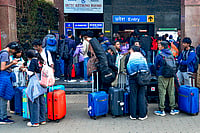In a bid to cash in on the millennium mania and rake in precious tourist dollars, the Union tourism ministry included Katchal two months ago in its much-hyped 'Explore India in the Millennium Year' pitch. With Katchal, it thinks it has hit a goldmine: more than 20,000 tourists are expected to head for the isle to watch the 'first' sunrise of the millennium here. Insists B.S. Banerjee, tourism director for the islands: It's going to be a historical event.
Environmentalists think otherwise. They're enraged at this effort to expose Katchal to millennium-mad hordes. The Andaman and Nicobar chapter of Intach says this will usher in a catastrophic celebration of a non-event in the island. They also point out that the first sunrise of the ensuing millennium will more accurately be on January 1, 2001, and not next year. That apart, there are more serious issues involved in opening up Katchal to tourists. Not surprisingly, many residents of the 36 inhabited isles do not welcome a deluge of tourists. Selecting Katchal as a tourist destination could turn out to be the biggest blunder of the millennium, avers Samir Acharya, chief of the Port Blair-based Society of Andaman and Nicobar Ecology (sane), an influential ngo working in the islands.
He's right. A third of the 12,000-strong population here, as per one estimate, comprises tribals. But the non-tribal population is swelling disconcertingly - up it jumped by a factor of three between 1971 and 1981. Clearly, the influx of non-tribals, in gross violation of existing laws that seek to protect the aboriginals, seems to be on the rise. Having swamped the Katchal tribals over the years, we now wish to further traumatise them with thousands of people from around the world, says Acharya. Has anybody bothered to take even their nominal consent?
But then nobody took the tribals' consent when a 2,340 hectare (ha) rubber plantation was allowed to come up on the island 30 years ago, challenging its status as a tribal reserve and a protected forest. Then, an oil palm plantation was raised on another 2,000 ha. The workers are mostly Sri Lankan Tamils displaced from their homeland. The upshot: over 90 per cent of the 17,450 ha of land on the island is occupied by forests and rubber and palm oil plantations. The entire population, therefore, lives on a mere 1,450 ha. Opening up Katchal to tourists further poses a health risk to locals, who lack resistance to many foreign pathogens. There's also the question of the disposal of waste generated by hordes of tourists and suspicions about gene-pirates masquerading as tourists landing on this fauna-rich island.
Besides, environmentalists have begun disputing the very basis of the hype being generated: that Katchal will witness the millennium's 'first' sunrise.At Calcutta's Positional Astronomy Centre where scientists are poring over the data, director K.K. Chakraborty says that since the Andamans are located in the east, it's natural the sunrise will be there first . The authoritative London-based Royal Greenwich Observatory is fuzzy on the issue. If we accept the purist view that the new millennium only starts at zero hours gmt, then the question is simply where the sun is rising at that instant, says the observatory's Robin Catchpole. On its way across the Bay of Bengal, it crosses Katchal, he affirms.
In Port Blair, sane members' calculated that sunrise in three other islands, including the volcanic Barren Island, will be at about the same time as in Katchal. They suggest the uninhabited Barren, with its colourful submarine lava formations and the world's only mammals - a flock of goats - that live on seawater, as a better sell to the sunrise tourists.
Why has the Andamans administration taken the retrograde step now of permitting 20,000 tourists of unknown vintage to visit Katchal? seethes Intach's B. Dutta Ray. One reason could be the slowdown of tourist arrivals at Andaman because of inadequate infrastructure: last year the 80,000-odd tourists represented a five per cent drop over '97. The archipelago has just 1,743 tourist beds; its snorkelling and deep-sea diving potential has never really been utilised.
The administration, however, is confident that no harm will come to the ecosystem. We don't want to disturb the local tribals, says Banerjee. We don't even need any permanent infrastructure. Temporary tents will suffice. But locals report the coming up of a long road, a pipeline and a powerhouse and that reclamation of low land is being carried out in contravention of coastal regulation laws. But there's hope yet. The home ministry still hasn't cleared the tourism ministry's proposal to open the island to tourists. For the people of Katchal, that could be the only silver lining.


























